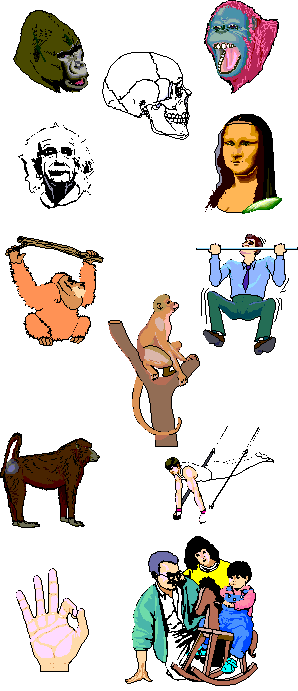

| Topics covered on this page are:
|
 |
The mechanisms that led to the evolution of the huge diversity of species living today are believed to be identical to those that led to the evolution of our own species (Homo sapiens).
Whilst the above is true in general, there are details of the evolution of humans which are still the subject of much research and sometimes much controversy.
It is generally accepted that humans share a common ancestor with the other primates, and many lines of evidence support this. Most textbooks will have a diagram showing the most likely relationships between primates. Some of the animals on this diagram survive today, others have long been extinct.

|
Look at the pictures of primates here, look at other primate pictures in your textbook, visit the Primate Gallery Web site, or best of all, take a trip to the Zoo and look at the primates there. You will see that all of these animals (including our own species), share many common structural, functional and behavioural characteristics, that is, there are many similarities in our phenotypes, including:
This seems too much of a coincidence to blame on convergent evolution. When the biochemical evidence, based on similarity of DNA sequence for selected, common genes, is examined, it is clear that all of these animals are closely related. |
Certainly not!
At least 4 million years ago the first hominid ancestor appears in the fossil record in Africa.
Eventually one species of hominid remained. Perhaps Homo sapiens was better adapted to survive a major environmental change. Perhaps 'he' was merely smarter and he directly or indirectly caused the extinction of other Homo species which were already beginning to migrate out of Africa.
![]() Back to the top of this page
Back to the top of this page
The evidence does seem strong that the origin of our species is somewhere in Africa, but the details will probably never be known for sure.
However, there is a great deal of evidence to show that many groups of early Homo sapiens migrated out of Africa about 200 000 years ago. The pressures of selection and adaptation that have been described for other species have acted on these population founding groups over the succeeding years and produced the sub-groups of the human species that we know as races.
Since interbreeding between members of different human races can and does occur, these groups must still be classified, according to the rules of taxonomy, as members of the same species.
Over hundreds of thousands of years, Hominids, and later members of the Genus Homo, gradually learned how to live and survive in a variety of environments. Major milestones in this journey from Hominid to modern man (Homo sapiens) have included:
For many years, humans have been manipulating the process of evolution to suit their own ends. By choosing organisms with desired phenotypes as breeding stock, humans are practicing artificial selection.
There is value in this practice when desirable characteristics such as disease resistance in crop plants is achieved. But sometimes undesirable results are obtained, such is the case with the development of antibiotic resistance in some pathogenic organisms.
As a result of human activity, rapid environmental changes have occurred in some locations. These, in turn, have changed ecosystems and habitats. As we have discussed earlier, mutations occur very slowly and are not necessarily favourable. It is, therefore, not surprising that many species are now endangered and many others have recently become extinct.
Recent advances in medical technology have reduced the incidence of death from human genetic disease, with affected individuals now remaining in the population long enough to reproduce. The implications for the frequency of the "disease" alleles in population gene pools should be obvious - they would be expected to increase. This may not seem to be a problem if the affected individuals can be treated, but the cost of such treatment may eventually place economic burdens on families and communities. Such issues will need to be addressed.